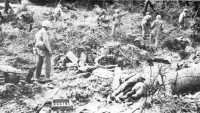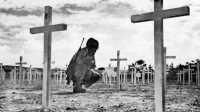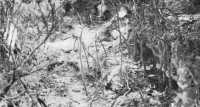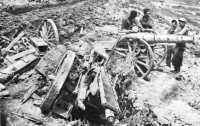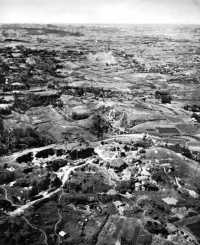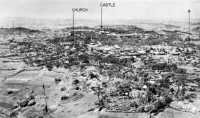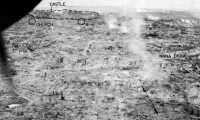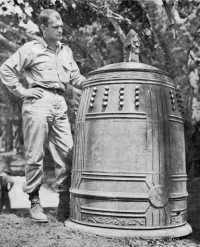Chapter 15: The Fall of Shuri
As the end of May approached, conflict had been raging on the Shuri line nearly two months and many an American soldier wondered whether Shuri would ever be taken or whether he would be alive to witness its capture. While on 21 May the eastern slope of Conical Hill had been taken, after more than a week of further fighting the high belt of Shuri defenses still held firm all around the ancient capital of the Ryukyus. The American gains in southern Okinawa had been confined to a rather small area of hills and coral ridges which, aside from Yontan and Kadena airfields seized on 1 April, had no important value for the attack on the Japanese home islands. It is true that these airfields, the flat extent of Ie Shima, and certain coastal areas of central Okinawa suitable for air base development were already swarming with naval and army construction battalions, at work on the task of making the island over into a gigantic, unsinkable carrier from which to mount the final air assault on Japan. But this was just a beginning. Most of the big prizes – the port of Naha, the big anchorage of Nakagusuku Bay, Yonabaru, Shuri, Naha airfield, and the flat coastal ground of southern Okinawa – were still effectively denied to the Americans, long after they had expected to capture them.
By the end of May, however, the flower of General Ushijima’s forces on Okinawa had been destroyed. The three major enemy combat units – the 62nd Division, the 24th Division, and the 44th Independent Mixed Brigade – had all been committed to the line and had all wasted away as a result of the incessant naval gunfire, artillery fire, air attacks, and the tank and infantry combat. Second-rate troops had for some time been present in the line, mixed with the surviving veterans of the regular combat units. By the end of May, 62,548 of the enemy had been reported killed “and counted” and another 9,529 estimated as killed. As compared with 3,214 killed in northern Okinawa and 4,856 on Ie Shima, 64,000 of these were reported killed in the fighting in the Shuri fortified zone. According to division reports, about 12,000 were killed by the 1st and 6th Marine Divisions and 41,000 by the 7th, 27th, 77th, and 96th Army Divisions while in the line at one time or another under XXIV Corps. The
largest number were killed by the 96th Division, credited with 17,000.1 Even though these reports of enemy losses are undoubtedly somewhat exaggerated, there is no question that Japanese forces, especially infantry combat units, had been seriously depleted. A conservative estimate would indicate that 50,000 of the best Japanese troops had been killed in the Shuri fighting by the end of May. The enemy’s artillery also was weakening noticeably as piece after piece was captured or was destroyed by naval gunfire, counter battery fire, and air bombing.
Nothing illustrates so well the great difference between the fighting in the Pacific and that in Europe as the small number of military prisoners taken on Okinawa. At the end of May the III Amphibious Corps had captured only 128 Japanese soldiers. At the same time, after two months of fighting in southern Okinawa, the four divisions of the XXIV Corps had taken only 90 military prisoners. The 77th Division, which had been in the center of the line from the last days of April through May, had taken only 9 during all that time.2 Most of the enemy taken prisoner either were badly wounded or were unconscious; they could not prevent capture or commit suicide before falling into American hands.
In the light of these prisoner figures there is no question as to the state of Japanese morale. The Japanese soldier fought until he was killed. There was only one kind of Japanese casualty – the dead. Those that were wounded either died of their wounds or returned to the front lines to be killed. The Japanese soldier gave his all.
Casualties on the American side were the heaviest of the Pacific war. At the end of May, losses of the two Marine divisions, whose fighting included approximately a month on the Shuri front, stood at 1,718 killed, 8,852 wounded, and 101 missing. In two months of fighting, chiefly on the Shuri front, the XXIV Corps suffered 2,871 killed, 12,319 wounded, and 183 missing. The XXIV Corps and the III Amphibious Corps had lost a total of 26,044 killed, wounded, or missing. American losses were approximately one man killed to every ten Japanese.3
Non battle casualties were numerous, a large percentage of them being neuropsychiatric or “combat fatigue” cases. The two Marine divisions had had 6,315 non battle cases by the end of May; the four Army divisions, 7,762. The most
“There was only one kind of Japanese casualty...”
Casualties – Our Losses: “one man killed to every ten Japanese.”
important cause of this was unquestionably the great amount of enemy artillery and mortar fire, the heaviest concentrations experienced in the Pacific war. Another cause of men’s nerves giving way was the unending close-in battle with a fanatical foe. The rate of psychiatric cases was probably higher on Okinawa than in any previous operation in the Pacific.4
If Japanese artillery and mortar fire shattered nerves to such an extent among American troops, some idea may be gained of the ordeal experienced by the Japanese when they were exposed to the greatly superior American fire power delivered by artillery, naval gunfire, and planes. The Japanese, however, were generally deep underground during heavy bombardment; the Americans were usually in shallow fox holes, in defilade, or exposed on the slope or crest of some ridge that was under attack.
The fighting strength of the American combat units engaged in southern Okinawa at the end of May stood at 45,980 for the III Amphibious Corps and 51,745 for the XXIV Army Corps. The infantry divisions, especially those of the Army, were considerably below strength. On 26 May the 77th Infantry Division had a strength, exclusive of attached units, of only 9,628 enlisted men; the 96th Infantry Division, 10,993. At the end of May the American troops were exhausted. Out of 61 days the 96th Division had been in the line 50 days, the 7th Division 49, the 77th Division the last 32, the 1st Marine Division the last 31, and the 6th Marine Division more than 3 weeks. In the two months of fighting in southern Okinawa the 7th and 96th Divisions had seen the most continuous service. The 7th Division in that time had had one rest period of 12 days, the 96th Division one of 11 days.5
For the veteran combat troops of the Japanese army, there was no rest once they were committed. With few exceptions they stayed in the line until killed or seriously wounded. Gradually, toward the end of May, more and more second rate troops from service units and labor groups were fed into the Japanese line to bolster the thinning ranks of the combat infantry.
American armor, which played so important a part in the ground action, had suffered heavily. By the end of May, not counting Marine tank losses, there had been 221 tank casualties in the four Army tank battalions and the one
armored flame thrower battalion. Of this total, 94 tanks, or 43 percent, had been completely destroyed. Enemy mines had destroyed or damaged 64 tanks and enemy gunfire 111. Such mishaps as thrown tracks or bogging down in bad terrain had accounted for 38, of which 25 were subsequently destroyed or damaged, mostly by enemy action. The 221 tank casualties constituted about 57 percent of the total number of Army tanks on Okinawa. At least 12 of the valuable and irreplaceable armored flame-throwing tanks were among those lost.6
Exodus From Shuri
American staff officers believed that the Japanese would fight at Shuri to the end. The struggle had gone on so long in front of Shuri that everyone apparently had formed the opinion that it would continue there until the last of the Japanese defenders had been killed. In a staff meeting at Tenth Army on 19 May Col. Louis B. Ely, intelligence officer of the Tenth Army, said that it looked as though the Japanese would fight at Shuri to the death. In another staff meeting, on the evening of 22 May, Colonel Ely, in commenting on the passage of the 7th Division down the Conical corridor, noted the absence of strong resistance to the move and interpreted this as supporting the view that the “Japs will hole up in Shuri.” At the same time General Buckner remarked: “I think all Jap first line troops are in the Shuri position. They don’t appear to be falling back.” On 25 May the Tenth Army periodic intelligence report stated that “evidence of captured documents, POW [Prisoners of War] statements, and air photographs tends to indicate that the enemy intends to defend the Shuri area to the last.”.7
Actually, the Japanese had for some time been preparing to evacuate Shuri. About 20 May, even before the final stretches of the eastern face of the Conical hogback fell to the 96th Division, the pressure on both flanks and the American gains in front of Shuri forced the Japanese command to realize that a decision must be made whether to fight to the end at Shuri, bringing all remaining resources to that area, or to withdraw from Shuri to other positions farther south. The loss of ground on the west flank in the vicinity of Sugar Loaf Hill
and Naha was not, indeed, considered by the Japanese as endangering too greatly the defense of Shuri, as they believed that they could meet this threat by withdrawing the flank to positions south and southeast of Naha. But the loss of the remaining positions on the east and south of Conical Hill made the defense of Shuri extremely difficult and tipped the scales.8
Decision Under Shuri Castle
On 21 May, the very day when the 96th Division completed the seizure of the eastern face of Conical and carved out the corridor to the south, General Ushijima called a night conference in the command caves under Shuri Castle. It was attended by all division and brigade commanders of the Japanese 32nd Army. Three alternative courses of action were proposed: a final stand at Shuri; withdrawal to the Chinen Peninsula; and withdrawal to the south.9
The first plan was favored by the 62nd Division, which had fought so long in the Shuri area and looked upon that part of the island defenses as peculiarly its own. The argument of General Fujioka, the division’s commander, was supported by the presence of large stores at Shuri and the general feeling that a withdrawal would not be in the best traditions of the Japanese Army. The second proposal, to retreat to the Chinen Peninsula, received little support from anyone; it was considered infeasible because of the difficulties of transportation over mountainous terrain and poor roads. The third possibility, that of withdrawing to the south, had in its favor the prospect of prolonging the battle and thereby gaining time and exacting greater attrition from the American forces. Other considerations favoring the plan were the presence in the south of positions prepared earlier by the 24th Division and the availability there of considerable quantities of stores and supplies.
For a time the trend of the discussion favored a final battle at Shuri, but it was generally conceded that this would result in a quicker defeat for the Japanese Army. The prospect of prolonging the battle by a withdrawal to the south was the determining consideration in the staff debate, and the decision was finally made to order a retreat to the south. The commanders present were directed to prepare for withdrawal from Shuri at the end of the month. The transport of supplies and wounded began the following night, 22-23 May. This final tactical deployment began silently, unsuspected by the Americans.
Discovery From the Air
From 22 May until the end of the month aerial observation over the enemy’s rear areas was limited by the almost constant overcast and the hard rains. Planes, however, were over the enemy’s lines for short periods nearly every day, and on 22 May groups of individuals, believed to be civilians, were observed moving south at dusk from Kamizato. The movement continued the following day. It was not believed that these people were soldiers since they were wearing white cloth. Leaflets had previously been dropped behind the Japanese lines telling the Okinawan civilians to identify themselves by wearing white and thus avoid being strafed and bombed. On 24 and 25 May aerial observation noted continued movement southward, but the impression persisted that it was civilian.10
The first doubt of the correctness of this view came on 26 May. In the afternoon the overcast lifted long enough for extensive aerial observation over the south end of the island. Movement extending from the front lines to the southern tip of the island was spotted. About 2,000 troops were estimated to be on the move between Oroku Peninsula and the middle part of the island below the Naha–Yonabaru valley. At 1800 from 3,000 to 4,000 people were seen traveling south just below Shuri. About a hundred trucks were on the roads in front of the Yaeju-Dake. At noon two tanks were observed pulling artillery pieces, and an hour later a prime mover towing another artillery piece was spotted. During the afternoon seven more tanks, moving south and southwest, were seen.
Pilots strafed the moving columns and reported that some of the soldiers seemed to explode when the tracers hit them-an indication that they probably were carrying satchel charges. Artillery and naval gunfire, guided by spotter planes, hit the larger concentrations of movement and traffic with destructive effect. Naval gunfire alone was estimated to have killed 500 Japanese in villages south of Tsukasan, and to have destroyed 1 artillery piece and 5 tanks.11
Just before dark, at 1902, a column of Japanese with its head near Ozato, just west of the Yuza-Dake, was seen in the far south of the island, moving north. Fifteen minutes later it was reported that this road was blocked to a point just above Makabe with troops moving north. The troop column extended over about 5,000 yards of road and was estimated to be in regimental strength.
Secret retreat of the Japanese from Shuri was difficult for Intelligence to discover because of pitted, wooded terrain such as this. Where, however, enemy could be found, they were scattered or destroyed
These Japanese howitzers were caught on the road leading south from Shuri
This was the largest enemy troop movement ever seen in the Okinawa campaign.12
The reports of the aerial observers on the 26th were perplexing. Enemy troops were moving in all directions. The majority, however, were headed south; the main exception was the largest column, which was moving north. The heaviest movement was in an area about five miles south of Shuri. It was noted that artillery and armor were moving south. What did it all mean? One careful appraisal concluded that the Japanese were taking advantage of the bad weather, poor aerial observation, and the general stalling of the American attack to carry out a relief of tired troops in the lines by fresh reserves from the south. It was believed that artillery was being moved to new emplacements for greater protection and for continued support of the Shuri battle.13
The next day, 27 May, little movement was noted behind the enemy’s lines in the morning, but in the afternoon from 2,000 to 3,000 troops were seen moving in both directions at the southern end of the island.14
After the reports of enemy movement on 26 May by aerial observers, General Buckner issued on 27 May an order directing that both corps “initiate without delay strong and unrelenting pressure to ascertain probable intentions and keep him [the Japanese] off balance. Enemy must not be permitted to establish himself securely on new positions with only nominal interference.”15 In view of the preponderance of other evidence it seems that this order was purely precautionary, and that there was no real conviction in the American command that the Japanese were actually engaged in a withdrawal from Shuri.
On 28 May the Tenth Army intelligence officer observed in a staff meeting that it “now looks as though the Japanese thinks holding the line around north of Shuri is his best bet. ... It is probable that we will gradually surround the Shuri position.”16 General Buckner indicated at this meeting that he was concerned about the possibility of a Japanese counterattack against the 7th Division on the left flank. He asked, “What has Arnold in reserve against counterattack?”17 On the following day, however, General Buckner said it looked as
though the Japanese were trying to pull south but that they had made the decision too late.18 On the day before, a total of 112 trucks and vehicles and approximately 1,000 enemy troops had been observed on the move to the south and southeast, in the vicinity of Itoman on the west coast, and around Iwa and Tomui in front of the Yaeju-Dake, a strong terrain position in the south.19 On 28 May Marine patrols found evidence of recently evacuated enemy positions west of Shuri.20 On 29 May there was almost no aerial observation because of a zero ceiling, and on 30 May practically no movement was seen behind the enemy’s lines.
American opinion on the meaning of the Japanese movements crystallized on 30 May. After a meeting with III Amphibious Corps and XXIV Army Corps intelligence officers the Tenth Army intelligence officer reported at a staff meeting on the evening of 30 May that they had reached a consensus that the “enemy was holding the Shuri lines with a shell, and that the bulk of the troops were elsewhere.” He estimated that there were 5,000 enemy troops in what he hoped would be the Shuri pocket, and stated that he did not know where the bulk of the Japanese troops were.21 At a staff meeting held on the evening of 31 May, it was suggested that the enemy would make his next line the high ground from Naha–Ko and the Oroku Peninsula on the west to Baten–Ko below Yonabaru on the east. At this meeting General Buckner stated that “he [General Ushijima] made his decision to withdraw from Shuri two days too late.”22 During the following days it became clear that the Americans had underestimated the scope of the enemy’s tactical plan and the extent to which it had been executed.
The Retreat South
Once the Japanese decision to withdraw had been made, steps were taken to carry out the withdrawal in an orderly manner. The major part of the transportation fell to the 24th Transport Regiment of the 24th Division. This unit had been exceptionally well trained in night driving in Manchuria, and as a result of its fine performance in the withdrawal from Shuri it received a unit citation from the 32nd Army. When the withdrawal from Shuri began only 80 of the 150 trucks of the transport regiment were left. One hundred and fifty Okinawan
Boeitai helped to load the vehicles. The formal order from 32nd Army headquarters to withdraw from Shuri was apparently issued on 24 May.23
The movement of supplies and the wounded began first, one truck unit moving out the night of 22 May. Communication units proceeded between 22 and 28 May to Mabuni and Hill 89, where the 32nd Army proposed to establish its new command post. The 36th Signal Regiment left Shuri on 26 May and arrived at Mabuni by way of Tsukasan on 28 May. Other units moved out early. The 22nd Independent Antitank Gun Battalion left the Shuri area on the night of 24.-25 May, withdrawing to the Naha–Yonabaru valley area, and at the end of the month continued on south to the southern end of the island. Remnants of the 27th Tank Regiment began to withdraw from Shuri on 26 May, passing through Kamizato. At the same time the 103rd and 105th Machine Cannon Battalions left the Shuri and Shichina areas and began the movement south, hand-carrying some of their guns.24
Of the major combat units of the 32nd Army, the 62nd Division left first. It began moving out of Shuri on 26 May, two days ahead of the original schedule, fighting delaying actions in the zone of the 7th Division, where the bulge had been pushed deep to the southwest of Yonabaru. The 44th Independent Mixed Brigade on the left flank in front of the 6th and 1st Marine Divisions was to begin withdrawing from the front lines on 26 May, but, because of the failure of naval ground troops to arrive and take over the lines, the evacuation of the front positions by the brigade had to be delayed two days, and it was not until 28 May that the withdrawal began in the western part of the line. The units of the brigade assembled behind the lines and made the move south in mass on the night of 1-2 June. One battalion, the 3rd, withdrew directly from Shuri. The 24th Division remained behind longest. Elements of the division fought in front of Shuri as late as 30 May, and the division headquarters itself did not leave Shuri until 29 May. The mortar battalions supporting the Shuri front had for the most part already left, their main movement south having taken place between 27 and 29 May.25
The evidence is conflicting concerning the date when the 32nd Army headquarters left Shuri. The cook for the 32nd Army staff said that the Army headquarters left Shuri on 26 May and arrived at the Hill 89 headquarters cave near Mabuni on 29 May. Officers of the 62nd Division confirmed this, stating that the Army headquarters left Shuri on 26 May, the same day the division itself started to move south. On the other hand, Colonel Yahara, 32nd Army operations officer, and Mr. Shimada, secretary to General Cho, stated that the Army headquarters did not move from Shuri until the night of 29 May. On the whole the evidence seems to indicate that the Army headquarters moved from Shuri before 29 May. On that day elements of the 1st Marine Division entered Shuri Castle, the 24th Division headquarters left Shuri, and only the last of the rear guard units were still in the line as a holding force. It seems improbable that the 32nd Army headquarters would have remained behind so long. It appears likely that the Army headquarters left Shuri at night between 26 and 28 May, possibly as early as 26 May.26
The main movement of 32nd Army combat units out of the inner Shuri defense zone took place from 26 to 28 May, some of the units, particularly the 62nd Division, fighting as they went. The 3rd Independent Antitank Battalion, the 2nd Battalion of the 22nd Regiment of the 24th Division, and part of the 17th Independent Machine Gun Battalion formed the principal components of the final holding force in front of Shuri, 29-31 May, after the 32nd Regiment withdrew.27
American Occupation of Shuri
As the battle lines tightened around Shuri at the end of May, the 1st Marine Division on the northwest and the 77th Division on the north and northeast stood closest to the town. Patrols reported no signs of weakness in the enemy’s determination to hold the Shuri position. Invariably they drew heavy fire when they tried to move forward. There was one exception to the reports of the patrols. On 28 May a patrol brought back to the 5th Marines, 1st Marine Division, the news that Shuri Ridge, the high ground south of Wana Draw, seemed to be held more lightly than formerly. (See Map 49. )
Shuri Heights, at southwest corner of the city, was approached by the marines from the low ground at right. First building to be taken was the Shuri Normal School (upper left). (Photo taken 28 April 1945.)
The Marines Take Shuri Castle
At 0730 on 29 May the 1st Battalion, 5th Marines, left its lines and started forward toward Shuri Ridge, where patrol action the previous day had indicated a possible weakness in the enemy’s lines. The high ground was quickly occupied. The 1st Battalion was now on the ridge that lay at the eastern edge of Shuri. Shuri Castle itself lay from 700 to 800 yards almost straight west across the Corps and division boundary. From all appearances, this part of the Shuri perimeter was undefended and the castle could be captured by merely walking up to it. The battalion commander immediately requested permission from his regimental commander to cross the Corps boundary and go into Shuri Castle. The request was approved, and at midmorning Company A of the 5th Marines started toward the spot that had been so long a symbol of Japanese strength on Okinawa. At 1015 Shuri Castle was occupied by Company A.28 The Marine unit entered Shuri through a gap in the covering forces caused by the withdrawal of the 3rd Battalion, 15th Independent Mixed Regiment of the 44th Independent Mixed Brigade, in the course of the Japanese retreat from Shuri.29 This seems to have been the only notable instance of confusion and mistake in the Japanese withdrawal operation as a whole. Everywhere else around Shuri the Japanese still held their covering positions in the front lines.
As a result of the unexpected entrance into Shuri, the 1st Marine Division at 0930 ordered the 1st Marines to bypass Wana Draw, leaving its position in the line next to the 77th Division, and to move around to the southwest to relieve the 1st Battalion, 5th Marines, in Shuri. This move was carried out with the 3rd Battalion leading and the 1st Battalion following. Enemy positions were bypassed on the right, and by night the two battalions had established a perimeter in the south of Shuri.
The elements of the 1st Marine Division which entered Shuri Castle had crossed over into the 77th Division zone of action and line of fire without giving that unit notice that such a movement was under way. The 77th Division learned of the move barely in time to cancel an air strike on the Shuri Castle area which it had scheduled.30
The next day, the Marine units at Shuri Castle and south of Shuri did not move, except for small patrols that were turned back by heavy machine-gun
and 47-mm. antitank fire a few hundred yards north of the castle. Vehicles could not reach the marines in Shuri and their supplies were critically low. Carrying parties of replacement troops formed an almost unbroken line from the west coast dumps all the way to Shuri. Many men collapsed from sheer exhaustion. Five air drops through heavy clouds to the marines in Shuri relieved somewhat their critical supply situation on 30 May.31
The entrances to the caves under Shuri Castle were still held by the enemy at 1330 on 30 May, and no additional ground had been taken in Shuri itself.32 The two Marine battalions, dug in, merely formed a pocket within the Japanese perimeter on which the enemy’s rear guard was fighting the holding battle around Shuri. The occupation of Shuri Castle did not cause these Japanese to withdraw from their covering positions or result in the occupation of Shuri itself; nor did it, so far as is known, affect the enemy’s plans. The marines themselves had all they could do to get food and water and some ammunition up to their position in order to stay.
The Crust Breaks
Although the holding party at 100 Meter Hill repulsed the 306th Infantry on 30 May when it attacked across the Marine line, elsewhere across the Shuri front key positions were wrested from the enemy in what obviously was a breaking up of the Japanese rear-guard action. Now for the first time there was convincing proof along the front lines that the Japanese had withdrawn from Shuri. (See Map 50.)
Dorothy Hill, a fortress directly east of Shuri and a tower of strength in the enemy’s inner line for the past two weeks, was attacked by the 3rd Battalion, 307th Infantry, 77th Division. The first platoon to reach the base of the hill was pinned down by heavy fire, the platoon leader and all noncommissioned officers being wounded. Other platoons maneuvered into position and finally one squad reached the crest at the right end. This entering wedge enabled two companies to reach the top, from which they discovered three levels of caves on the reverse slope. They went to work methodically, moving from right to left along the top level, burning and blasting each cave and dugout, the flame-thrower and satchel-charge men covered by riflemen. When work on the top level was finished, the second level of caves and tunnels received similar treatment, and then the third and lowest level. That night fifteen Japanese who had survived
the day’s fighting crawled out of the blasted caves and were killed by Americans from their foxholes. A great amount of enemy equipment, including ten destroyed 150-mm- guns and twenty-five trucks, was found on the south (reverse) side of Dorothy Hill, testifying to the enemy fire power at this strong point. On 30 May, the 77th Division also took Jane Hill on its left flank and then almost unopposed took Tom Hill, the highest point of ground in the Shuri area, by 1700.33
For nine days elements of the 96th Division had been stalemated at the base of Hen Hill, just northeast of Shuri. On the 30th, Company F and one platoon of Company G, 382nd Infantry, resumed the attack on Hen Hill. Pfc. Clarence B. Craft, a rifleman from Company G, was sent out ahead with five companions to test the Japanese positions. As he and his small group started up the slope, they were brought under heavy fire from Japanese just over the crest, and a shower of grenades fell on them. Three of the men were wounded and the other two were stopped. Craft, although a new replacement and in his first action, kept on going, tossing grenades at the crest. From just below the crest he threw two cases of grenades that were passed up to him from the bottom, those of the enemy going over his head or exploding near him. He then leaped to the crest and fired at point-blank range into the Japanese in a trench a few feet below him. Spurred by Craft’s example, other men now came to his aid. Reloading, Craft pursued the Japanese down the trench, wiped out a machine gun nest, and satchel-charged the cave into which the remaining Japanese had retreated. Altogether, in the taking of Hen Hill as a result of Craft’s action, about seventy Japanese were killed, at least twenty-five of whom were credited to Craft himself. This daring action won him the Congressional Medal of Honor.34
To the left (east), Company F at the same time engaged in a grenade battle for Hector Hill, using ten cases of grenades in the assault on the crest. It was finally won after a satchel charge was hurled over the top and lit in the enemy trench on the other side, parts of Japanese bodies and pieces of enemy equipment hurtling into the sky in the blast. Hen and Hector Hills had fallen by 1400.35
On the 96th Division’s left rapid advances were made on 30 May. Roger Hill was seized when the Japanese failed to man their combat positions quickly
Shuri, photographed 28 April (above) and 23 May 1945 (below). Ruins shown in lower picture include Methodist Church and a 2-story concrete structure (circle A). Dotted outline in photos indicates the castle wall.
enough after an artillery barrage that had driven them to cover. They were killed to a man by the infantry, which surprised them when they tried to reach their fighting positions. Sgt. Richard Hindenburg alone killed six of the enemy with his BAR. The 3rd Battalion, 381st Infantry, went down the western slope of the Conical hogback to find from 75 to 100 dead Japanese on the reverse slope of Cutaway Hill. At last the ad Battalion, 383rd Infantry, reached Love Hill and dug in, although scattered fire was still received from a machine gun in a nook of Charlie Hill and there were a few live Japanese on Love itself. In the afternoon the 3rd Battalion, 383rd Infantry, left its foxholes on Oboe, where it had experienced so great an ordeal, and proceeded down the reverse slope of the hill, finding only a few scattered Japanese. That night the 383rd Infantry expressed a heartfelt sentiment when it reported “infinite relief to have Conical Hill behind us.” Although there had been suicidal stands in a few places by the last of the holding force, the advances had been rapid.36
On 31 May the 77th Division walked over 100 Meter Hill at the eastern end of Wana Ridge and on into Shuri. The marines from the vicinity of Shuri Castle moved north without opposition to help in the occupation of the battered rubble. Overnight the enemy had stolen away. When darkness fell on 31 May the III Amphibious Corps and the XXIV Corps had joined lines south of Shuri and the 77th Division had been pinched out in the center of the line at Shuri. The troops rested on their arms before beginning the pursuit south with the coming of dawn.37
Crater of the Moon
Shuri, the second town of Okinawa, lay in utter ruin. There was no other city, town, or village in the Ryukyus that had been destroyed so completely. Naha too had been laid waste. Certain villages which had been strong points in the enemy’s defense, such as Kakazu, Dakeshi, Kochi, Arakachi, and Kunishi, had been fought over and leveled to the ground. But none of these compared with the ancient capital of the Ryukyus. It was estimated that about 200,000 rounds of artillery and naval gunfire had struck Shuri. Numerous air strikes had dropped 1,000-pound bombs on it. Mortar shells by the thousands had arched their way into the town area. Only two structures, both of concrete, the big normal school at the southwestern corner and the little Methodist
The Shuri Castle bell, with an American officer standing by. The bell is a companion to one brought to the U.S. Naval Academy by Commodore Perry
church, built in 1937, in the center of Shuri – had enough of their walls standing to form silhouettes on the skyline. The rest was flattened rubble. The narrow paved and dirt streets, churned by high explosives and pitted with shell craters, were impassable to any vehicle. The stone walls of the numerous little terraces were battered down. The rubble and broken red tile of the houses lay in heaps. The frame portion of buildings had been reduced to kindling wood. Tattered bits of Japanese military clothing, gas masks, and tropical helmets-the most frequently seen items-and the dark-colored Okinawan civilian dress lay about in wild confusion. Over all this crater-of-the-moon landscape hung the unforgettable stench of rotting human flesh.38
On a high oval knob of ground at the southern edge of the town, Shuri Castle had stood. Walls of coral blocks, 20 feet thick at the base and 40 feet in height, enclosed the castle area of approximately ago acres. The castle in its modern form had been constructed in 1544, the architecture being of Chinese origin. Here the kings of Okinawa had ruled. Now the massive ramparts, which had been battered by 14- and 16-inch shells from American battleships, remained intact in only a few places. Inside the castle area one could discern the outline of the rubble-strewn and pitted parade ground. Magnificent large trees that had graced the castle grounds were now blackened skeletons on the skyline.
From the debris of what once had been Shuri Castle two large bronze bells, scarred and dented by shell fire, were dug out by the troops. One of them was about five feet in height, the other three and a half. Cast about 1550, they were inscribed with characters that may be translated as follows:–
In the Southern Seas lie the islands of Ryukyu Kingdom, known widely for their scenic beauty. The Kingdom of Ryukyu embraces the excellent qualities of the three Han states of Korea and the culture of the Mings. Separated as it is from these nations by distance, still it is as close to them as lips to teeth. ...
Behold! What is a bell? A bell is that which sounds far, wide, and high. It is a rare Buddhist instrument, bringing order to the routine of the monk. At dawn it breaks the long stillness of the night and guards against the torpidity of sleep. ...
It will always ring on time, to toll the approach of darkness, and to toll the hour of dawn. It will startle the indolent into activity that will restore honor to their names. And how will the bell sound? It will echo far and wide like a peal of thunder, but with utmost purity. And evil men, hearing the bell, will be saved.39
